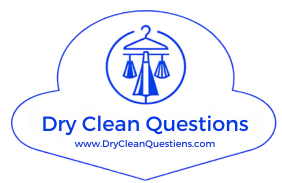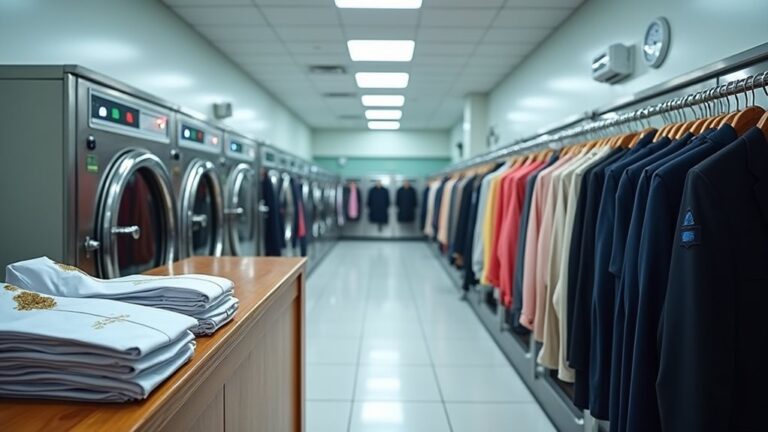The dry cleaning symbol you’ll spot on care labels is a simple circle, and trust me, learning to decode it has saved me from countless laundry disasters over the years. When you see a plain circle, it means professional dry cleaning is recommended, while a circle with an X through it screams “absolutely no dry cleaning!” Letters inside like “P” or “F” tell your cleaner which solvents are safe to use, and additional bars underneath indicate gentle or delicate handling requirements. Understanding these symbols becomes your secret weapon for keeping those expensive garments looking pristine, and there’s so much more these little circles can reveal about proper fabric care.
Understanding the Basic Dry Cleaning Circle Symbol
That mysterious little circle sitting quietly on your garment’s care label holds more power than you might imagine, and I learned this the hard way when I confidently tossed my favorite silk blouse into the washing machine, only to watch it emerge looking like it had been through a fabric tornado 😅.
That innocent little circle on your care label? It’s basically your garment’s cry for help before meeting its washing machine doom.
This simple circle symbol is your garment’s way of saying “please take me to professional dry cleaners,” because certain delicate fabrics simply can’t handle water and regular detergent.
When you see a cross over the circle, that’s a firm “no” to dry cleaning entirely, as the solvent could damage the material’s integrity.
You might also encounter labels that say dry clean recommended, which means the garment can be safely dry cleaned but doesn’t necessarily require it, unlike “dry clean only” which mandates professional cleaning.
Understanding this basic dry cleaning symbol will save you from my expensive mistake.
Letters Inside the Circle: Chemical Solvent Codes
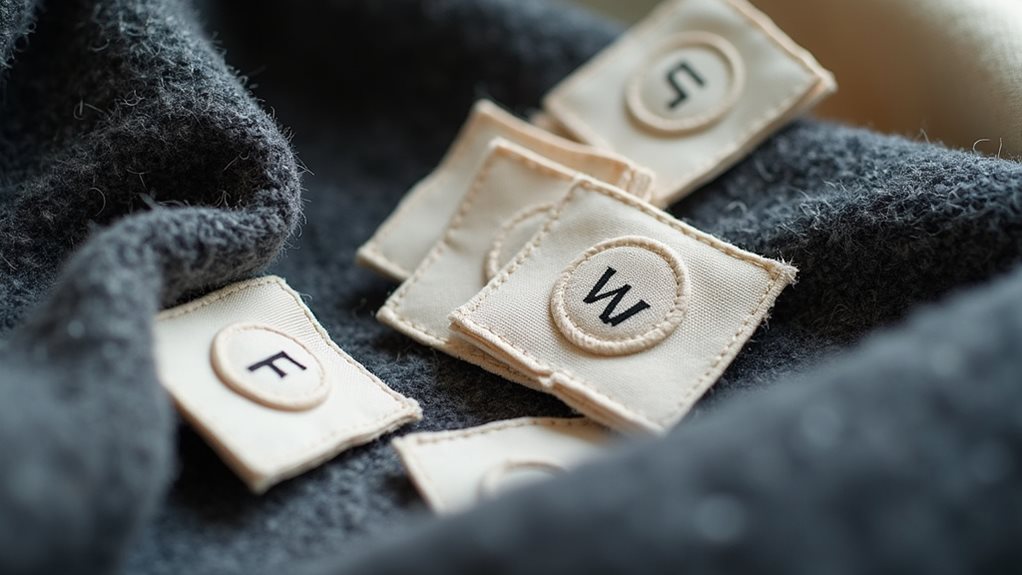
When you spot those mysterious letters tucked inside the dry cleaning circle, you’re actually looking at a secret code that tells professional cleaners exactly which solvents they can safely use on your precious garments.
I’ll admit, I used to ignore these tiny symbols completely until I watched my favorite silk blouse get ruined because the cleaner used the wrong chemical treatment – now I’m like a detective examining every care label!
These letter codes, typically “A,” “P,” or “F,” serve as your fabric’s insurance policy, guaranteeing that dry cleaning professionals follow the manufacturer’s specific requirements to keep your clothes looking fabulous for years to come.
The “P” designation specifically indicates that perchloroethylene (PERC) can be used, which remains the most common solvent in professional dry cleaning operations due to its effectiveness at dissolving oils and greases without damaging delicate fabrics.
Common Solvent Letter Codes
Although I’ve spent countless hours deciphering care labels like they’re ancient hieroglyphics 😅, those mysterious letters tucked inside the dry cleaning circle actually follow a surprisingly logical system that, once you understand it, makes choosing the right cleaner feel less like gambling with your favorite clothes.
The letter A inside your dry cleaning symbol means any solvent works perfectly for the cleaning process, making it the easiest option when you need something professional dry cleaned.
Letter F indicates any solvent except trichloroethylene is safe, while letter P restricts the care label to petroleum solvents only, which protects delicate fabrics requiring gentler treatment during their spa day at the cleaners.
Professional dry cleaners primarily rely on perchloroethylene as their go-to solvent because it effectively dissolves oils and greases that water-based washing simply cannot tackle.
Professional Cleaning Requirements
Professional dry cleaning transforms from a mysterious ordeal into a manageable process once you realize that those tiny letters inside the circle fundamentally serve as your garment’s passport, telling the cleaner exactly which chemical solvents will pamper your clothes rather than destroy them.
Understanding these solvent codes protects your garment integrity while guaranteeing the proper cleaning method gets applied to your professional dry cleaned items.
When you’re examining your care label, you’ll encounter three main precaution required indicators:
- “A” symbol – Allows any chemical solvent, giving cleaners complete flexibility
- “P” symbol – Restricts cleaning to petroleum-based solvents only
- “F” symbol – Permits any solvent except trichloroethylene
The “P” designation specifically indicates that tetrachloroethylene (commonly known as “perc”) and other petroleum-derived solvents can be safely used to effectively dissolve oils and grease while preserving delicate fabrics like silk and wool.
Additional Bars and Lines: Precaution Levels
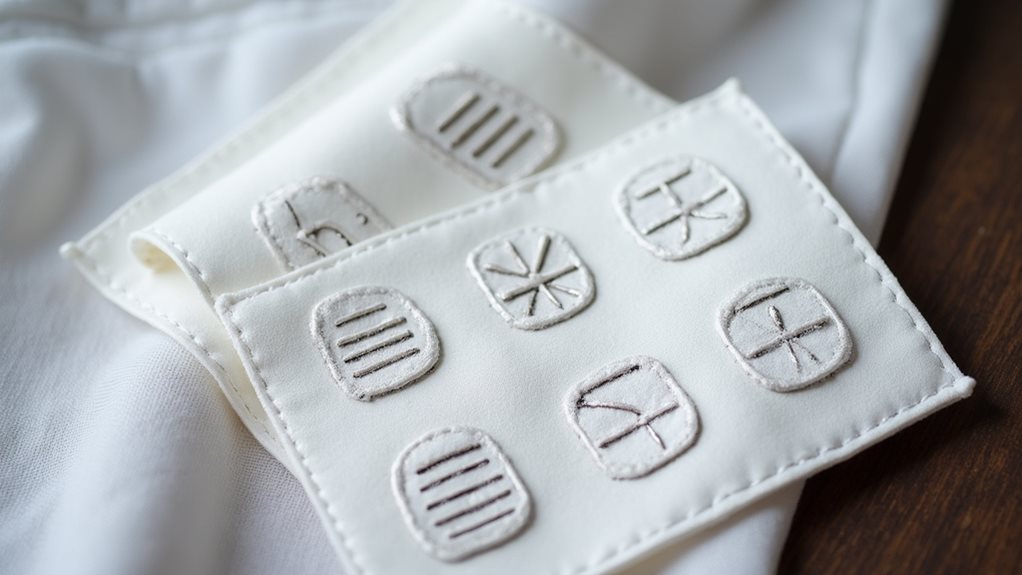
While you might think a simple circle tells the whole dry cleaning story, those mysterious little bars and lines beneath the symbol actually hold the key to preserving your most treasured garments.
Here’s what I’ve learned from countless trips to professional cleaners: one bar beneath the dry cleaning symbol means your item needs gentle care, while two bars signal that your garment requires the most delicate handling possible.
These precaution levels aren’t just suggestions—they’re your garment’s care tag speaking directly to the cleaner about which solvent and techniques to use.
Trust me, ignoring these additional bars is like telling someone to handle your grandmother’s china casually; it rarely ends well when items aren’t professionally dry cleaned with proper care instructions.
Understanding these symbols becomes especially crucial for delicate fabrics like silk, wool, and cashmere that can be easily damaged without the appropriate level of professional care.
Do Not Dry Clean: The Crossed-Out Circle
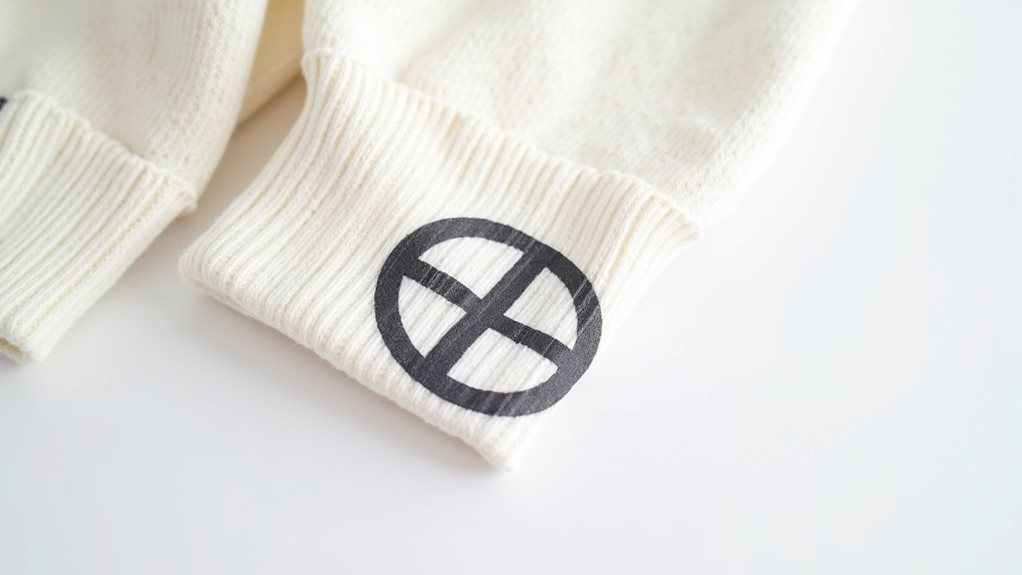
Sometimes those bars and lines give way to something far more definitive: a circle with a bold X slashed right through it, and let me tell you, this symbol doesn’t mess around.
When your care tag indicates don’t dry clean with that crossed-out circle, you’re looking at fabric that literally can’t handle dry cleaning solvents without suffering serious damage to its garment structure.
That crossed-out circle isn’t just a suggestion—it’s your fabric’s desperate plea to avoid chemical destruction at all costs.
Here’s what you need to know about alternative cleaning methods:
- Spot cleaning becomes your best friend for small stains and mishaps.
- Home washing might work if the fabric allows gentle hand-washing.
- Professional consultation with specialty cleaners who understand delicate fabric integrity.
This symbol isn’t being dramatic—it’s protecting your investment from professional cleaning processes that could ruin everything you love about that piece. Unlike water-based washing that can cause fabric shrinkage or color bleeding, chemical solvents used in dry cleaning can break down certain synthetic materials or specialty finishes in ways that are completely irreversible.
Professional vs. Home Care Considerations
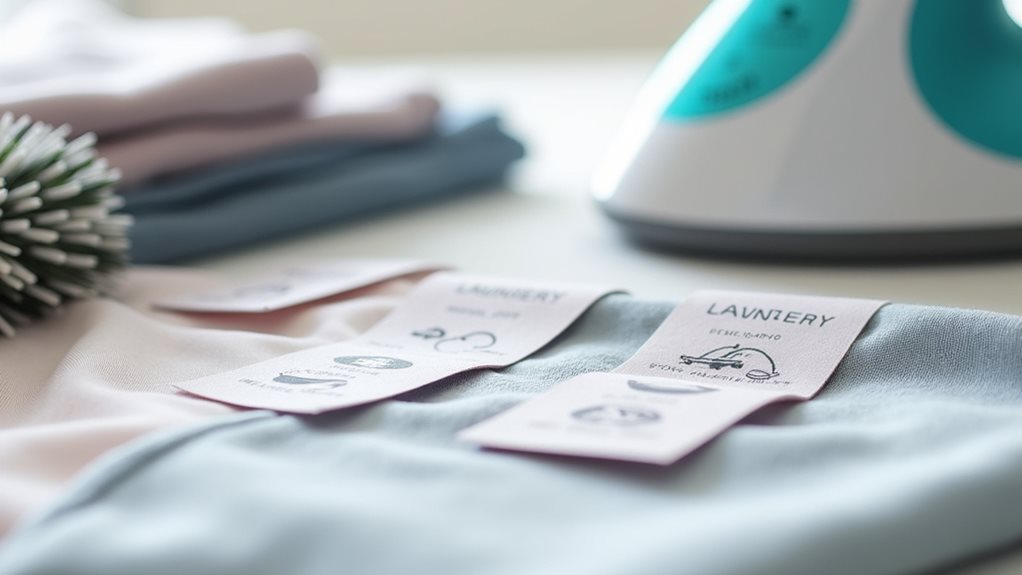
When you’re standing in your closet, holding that gorgeous silk blouse with the little circle symbol, you’re fundamentally facing a three-way decision that’ll impact your wallet, your wardrobe’s longevity, and your precious weekend time.
Sure, professional dry cleaning might cost you $8-15 per garment compared to tossing it in your home washer for mere pennies, but I learned the hard way that saving money isn’t always worth it when my favorite cashmere sweater turned into doll clothes after one “gentle cycle” experiment 😅.
The real question becomes whether you prioritize convenience, quality results, or keeping your budget intact, and honestly, each factor deserves serious consideration before you make that trip to the cleaners or risk it all at home.
Keep in mind that excessive dry cleaning can actually damage your clothes over time through repeated chemical exposure, so finding the right balance is key to maintaining your garments properly.
Cost Comparison Analysis
How much should you really spend to keep your favorite clothes looking their best, and is professional dry cleaning worth the extra cost compared to handling things at home?
Here’s what I’ve learned after years of wrestling with this dilemma:
- Professional services charge $10-30 per garment, but they’ll rescue your silk blouse from disaster using specialized cleaning agents that actually work.
- Home care methods cost pennies in detergent, though I’ve personally shrunk enough sweaters to stock a doll wardrobe 😅
- Delicate fabrics like wool demand professional maintenance, while sturdy cotton handles your washing machine just fine.
The real cost comparison isn’t just money—it’s about protecting your investment.
Sure, dry cleaning seems expensive upfront, but replacing damaged garments after botched home stain removal? That hurts your wallet and your heart.
Professional dry cleaners use chemical solvents instead of water, which means they can tackle oil-based stains and preserve fabric integrity in ways that home washing simply cannot match.
Quality and Results
Although we’ve established that professional dry cleaning costs more upfront, the quality difference between professional and home care becomes crystal clear once you see your garments side by side.
When you spot that dry cleaning symbol, it’s your fabric’s way of saying “treat me with expertise.” Professional dry cleaning services understand delicate fabrics in ways your washing machine simply can’t, using specialized solvents and techniques during the cleaning process that preserve garment integrity.
I’ve watched countless clients attempt home washing methods on silk blouses or wool suits, only to end up with shrunken disasters 😅.
Professional cleaning excels at stains treatment that would stump you at home, while maintaining color vibrancy and shape that translates into longer-lasting garments worth every penny. The process is particularly effective at removing oil-based stains and grease that water-based cleaning methods often struggle to eliminate.
Convenience Factor Assessment
Since most of us are juggling packed schedules between work, family, and that endless to-do list that somehow keeps growing, the convenience factor becomes a major deciding point when you’re staring at that dry cleaning symbol on your favorite blazer.
Professional services offer three game-changing advantages:
- Expert handling saves you from researching cleaning methods for delicate fabrics.
- Complete stain removal without the guesswork and potential disasters.
- Time freedom while professionals handle pressing and garment care.
When clothing care symbols indicate dry cleaning, you’re fundamentally getting a roadmap to garment longevity.
Sure, you could attempt home care, but there’s something beautifully liberating about handing over that silk dress to trained professionals who understand the science behind proper fabric treatment, giving you precious hours back for life’s more enjoyable moments. Professional dry cleaners use chemical solvents instead of water to safely clean delicate materials without compromising fabric integrity or causing shrinkage.
Common Fabrics That Require Dry Cleaning
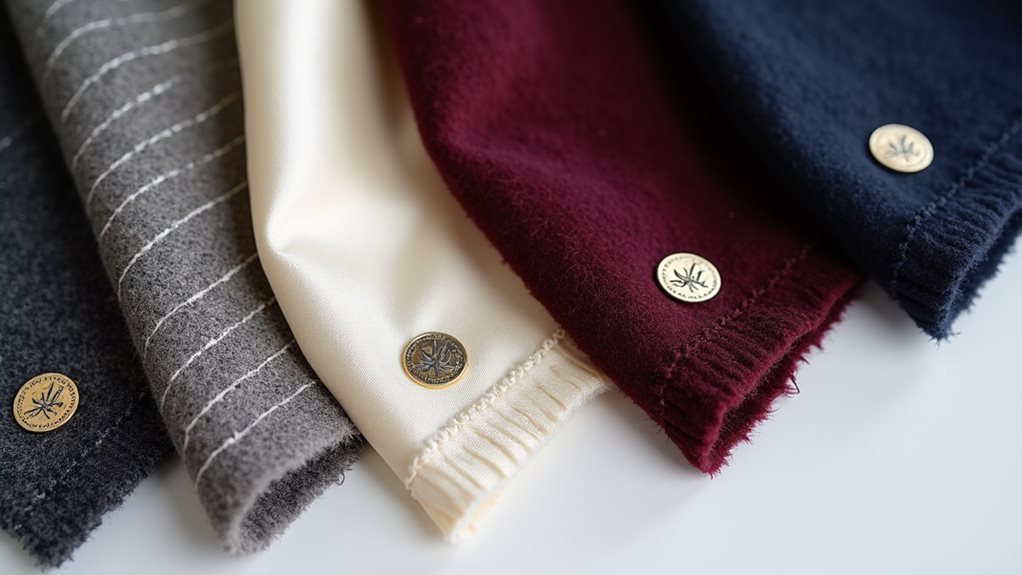
When you’re standing in your closet wondering which clothes actually need that mysterious dry cleaning treatment, certain fabrics practically wave their hands demanding professional attention.
Delicate fabrics like silk, wool, and rayon can’t handle your washing machine’s aggressive tumbling—trust me, I’ve learned this the hard way with a gorgeous silk blouse that turned into doll clothes 😅.
High-end garments, especially those customized suits and evening dresses, need professional dry cleaning to maintain their structure and sophistication.
Synthetic fibers in blends often require special care too, while upholstery fabrics like velvet will punish you with shrinkage if you attempt home washing.
Wedding dresses and beaded pieces absolutely must be dry cleaned—those intricate details deserve expert handling to preserve your precious memories.
Alternative Cleaning Methods for Dry Clean Only Items
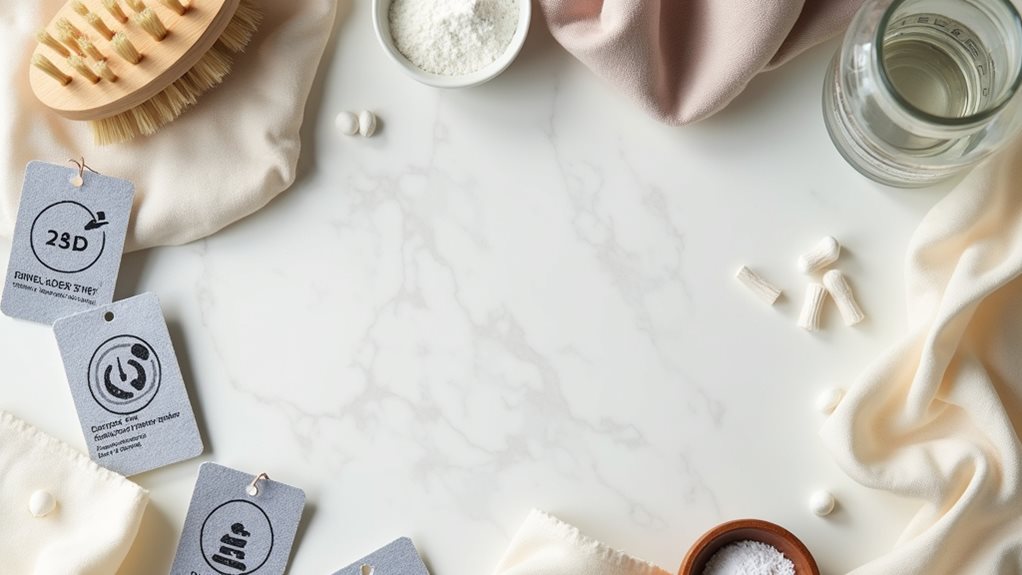
Before you resign yourself to expensive dry cleaning bills every time you spot that little circle symbol, let me share some gentle alternatives that have saved my budget and my sanity over the years.
That dry cleaning symbol doesn’t always mean professional cleaning is your only option, especially when you’re dealing with minor issues on delicate fabrics.
Here are three alternative cleaning methods I’ve successfully used:
- Gentle hand washing in cold water for less delicate items, though always check your test area first.
- Spot cleaning with mild detergent for targeted stain removal without risking garment damage.
- Fabric steamer treatments to refresh and dewrinkle without moisture exposure.
For stubborn issues, specialized cleaning solvent can work wonders, but patience and caution prevent costly mistakes.
Reading Dry Cleaning Symbols Alongside Other Care Labels
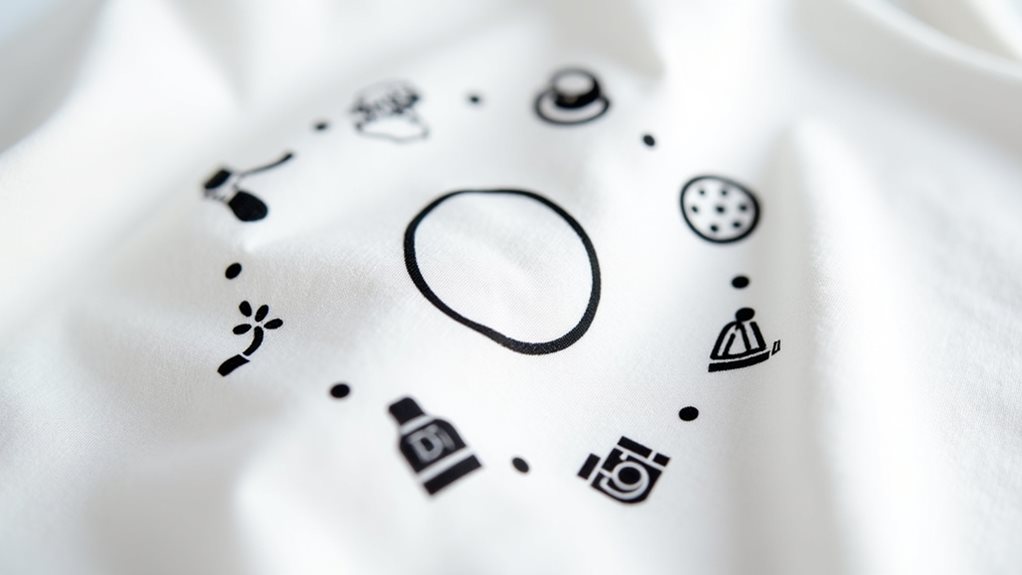
Those gentle alternatives work beautifully when you understand exactly what you’re working with, but here’s where I learned the hard way that the dry cleaning symbol never exists in isolation on your garment’s care label.
You’ll always find it alongside washing, bleaching, and ironing symbols, and reading them together tells the complete story of proper garment care.
When I see that little circle indicating professional dry cleaned only, I immediately check if there’s a specific solvent letter inside and note any bars underneath showing the level of precaution needed.
Understanding these symbols together prevents items from being damaged and helps extend lifespan greatly—trust me, replacing a favorite blazer teaches you this lesson quickly! 😅
